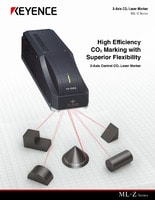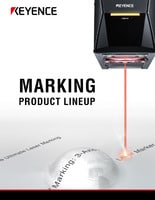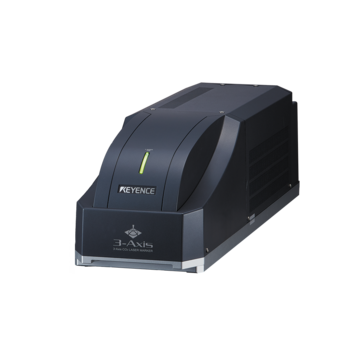Industrial Laser Marking Systems / Laser Markers
Laser Engraving on Acrylics
-
Tags:
- Laser Engraving , Laser Cutting , Laser Drilling
Polymethyl Methacrylate, commonly known as acrylic, is a versatile thermoplastic used in various forms for clothing, paint production, and solid components. Acrylic adaptability allows it to be useful in many applications. In the following, we will focus on engraving solid acrylic components in the aerospace, automotive, and medical device industries.
When it comes to engraving acrylic components, laser engraving acrylic is the go-to solution. Laser markers excel because of the permanent, fast, and precise mark that is compatible with acrylic. Laser engraving acrylic is particularly notable for reliable traceability marks that are compliant with industry and governmental standards. If you’re looking to learn more about laser engraving acrylic and how to implement it, the following should be useful.
Why Choose Lasers for Acrylic Engraving
The benefits of acrylics, like durability, resistance to chemicals, and stiffness, are useful for components, but these characteristics make acrylic a difficult material to mark. However, laser engraving acrylic is compatible with most shapes, very precise, and permanent.
Precision
Lasers are known for acrylic engraving with precision down to the width of a human hair. This is especially valuable for engraving traceability and identification marks on acrylic components. The engravings are crisp and clear, maintaining reliable and easy-to-read marks. Not only is this level of detail valuable for the mark itself, but it also is useful for smaller components with limited marking space.
Speed and Efficiency
Laser engraving acrylic is a quick process, completing markings in seconds. As a result, the cost per engraving is low.
Permanent
Acrylic’s popularity is largely due to its impact, weatherability, UV, and chemical resistance. These strengths make acrylic a preferred material in industries such as aviation, automotive, and medical equipment. Considering the durability of acrylic, an acrylic mark must also be resilient.
Laser engraving acrylic meets this expectation well. It is a permanent marking method that leaves an engraving that endures all changing environments.
We’re here to provide you with more details.
Reach out today!

Best Acrylics to Use for Laser Engraving
Cast Acrylic
Cast acrylic earns its name from the manufacturing process known as “casting.” This category of acrylic is known for stiffness, sturdiness, chemical resistance, and sometimes uneven surface area.
Laser engraving cast acrylic produces a frosted engraved appearance, which is visually appealing and has high contrast. Cast acrylic is the more common type of laser-engraved acrylic, but because of its appearance, cast acrylic is expensive.
Extruded Acrylic
Extruded acrylic derives its name from the manufacturing process “extrusion.” Unlike cast acrylic, this type of acrylic is cheaper and has an even surface area. Extruded acrylic is also softer than cast acrylic. When laser engraving extruded acrylic, the result is a transparent mark.
Discover more about this product.
Click here to book your demo.

Best Laser to Use for Engraving Acrylics
Out of all the lasers: fiber, UV, green, and CO2, the best laser to engrave acrylics is a CO2 laser marker because the acrylic absorbs the CO2 laser beam. When choosing a CO2 laser, it’s best to choose one with 3-axis control and integrated software.
CO2 Laser
A CO2 laser engraver is the best choice because the light is easily absorbed by the acrylic. The absorption means that once the beam hits the acrylic surface, the target surface immediately vaporizes. The vaporized material leaves behind a clean mark.
3-Axis Control Laser
3-Axis control in a laser system provides engraving on an XYZ plane, offering more flexibility and precision than a standard XY plane. This type of control is most useful for parts with varying heights, depths, or contours. Lasers without 3-axis control often leave a distorted mark on curved edges because of the misalignment to the XY plane.
3-Axis control moves around curves and steps for an even engraving. It’s especially important for acrylic engraving because acrylic applications are sometimes of odd shapes or sizes.
Integrated Software
Laser engraving on acrylic is used for designs, text, numbers, and 2D codes. Since there’s a range of types of marks, it’s best to use a laser that has software for switching between markings, imitating uploaded markings, and evaluating markings.
We’re here to provide you with more details.
Reach out today!

Applications that Benefit from Laser Engraving Acrylics
Laser engraving acrylic benefits any application needing a permanent and precise mark. Having said that, laser engraving acrylic particularly benefits applications requiring traceability marks. These marks usually fall under industry or governmental regulations and are held to strict standards. In this section, we’ll highlight aircraft labels, medical devices, and instrument panel traceability marks.
Laser Engraving Acrylic Aircraft Labels
Acrylic is used for inflammable identification and traceability labels on aircraft. These labels withstand UV radiation, temperature changes, chemical exposure, and varying weather. The Federal Aviation Administration (FAA) also requires these labels to still be visible in the case of an aircraft crash.
With the high expectations and intense exposure, using laser engraving on acrylic labels is ideal. The engravings will withstand all environments and be readable for identifying the plane and tracing components.
Laser Engraving Acrylic Medical Devices
Cuvettes, tubes, test kits, syringes, and surgical trays are examples of medical devices made of acrylic. These devices are manufactured from acrylic because of the material’s resistance to biological and chemical contaminants.
The Federal Drug Administration (FDA) requires each of these medical devices to have a unique device indicator (UDI). A UDI is a 2D code that’s readable by humans and robots that stores supply chain and medical use information. UDIs prevent counterfeits, ensure quality assurance, and streamline traceability. These codes are expected to be permanent and withstand the medical device’s lifetime.
Laser engraving UDIs on acrylic medical devices is compliant with the FDA regulations. The engravings are permanent, so they withstand biological and chemical exposure. Additionally, the engravings are clear enough to be read by humans and robots.
Laser Engraving Acrylic Instrument Panels
Acrylic is used for instrument panels because of its light transmission, moldability, and resistance to UV rays, contaminants, and general wear and tear. The acrylic illuminates the light-up signals such as the check engine light, seatbelt sign, speedometer, and others.
The automotive industry values traceability to prevent counterfeits and have speedy recalls. Since the industry relies on mass production, thousands of parts are pushed out every day from different manufacturing plants. Traceability marks, a practice called direct part marking, is vital for organization.
Laser engraving is best for adding direct part marks on instrument panels. The engraved marks withstand all exposure and are small enough to mark the panel without distracting from the controls.
Curious about our pricing?
Click here to find out more.

Integrating Laser Engraving Acrylics into Your Part-Tracing Applications
Laser engraving acrylic is a guaranteed way for your marks to last as long as your acrylics do. Regardless of your industry—medical, automotive, or aerospace—using laser engraving on acrylic produces a fast, permanent, and precise mark. It is best to use a CO2 laser engraver for acrylic because the beam vaporizes the acrylic target and leaves a clean mark.
If you’re marking intricate designs or engraving on an odd shape like an instrument panel or medical device, KEYENCE recommends our 3-Axis Control CO2 Laser Marker ML-Z Series. The ML-Z includes a 3-Axis Control for distortion-free engravings even on components with curves, depth, and height differences.
Laser engraving on acrylic for part tracing is your best way to stay compliant with high contrast, precise, and permanent marks. Contact us today for your CO2 laser.
Get detailed information on our products by downloading our catalog.
View Catalog


![LASER PROCESSING REPORT [Cutting an Acrylic Plate]](/img/asset/AS_48505_L.jpg)


